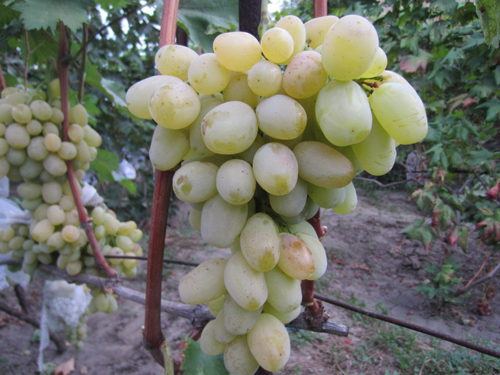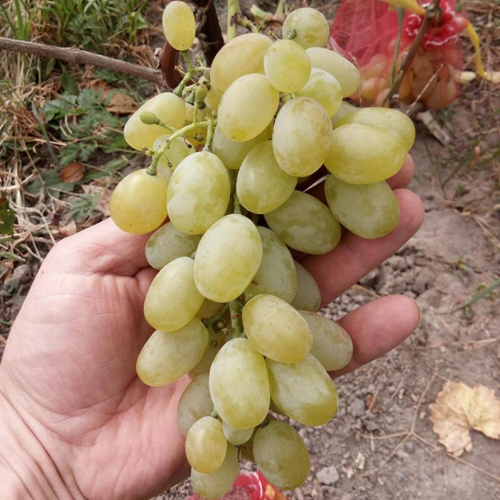Grape variety Valentine
In recent years, we have become accustomed to waiting for new hybrid forms of grapes, primarily from amateur breeders, who have greatly enriched the assortment of crops in our garden and backyard plots. However, scientists do not remain aloof from this process, offering winegrowers their most interesting developments, which often, in addition to excellent commercial qualities, are also distinguished by complex resistance to unfavorable environmental factors, unpretentiousness and plasticity in cultivation.

One of such brainchildren of the employees of the All-Russian Scientific Research Institute of Viticulture and Winemaking named after V.I. ME AND. Potapenko, Novocherkassk, Rostov region, is a hybrid form of grapes called Valentina. It was obtained as a result of crossing a complex hybrid of Ukrainian origin Demeter with a rather old variety Muscat Summer, originally from Moldova. The author of the novelty is a female research team consisting of Svetlana Ivanovna Krasokhina, Valentina Alekseevna Ganich and Lyudmila Alekseevna Maistrenko.
The variety obtained by them turned out to be very promising in terms of a number of parameters. First of all, it is distinguished by large-fruited, expressed in the impressive size of both bunches and berries, high taste of fruits, which also have a slight aroma of nutmeg, increased resistance of bushes to frost and a number of common fungal diseases. Even such a dangerous pest of grapes as the root phylloxera causes relatively little damage to the hybrid, and therefore on light soils it can be cultivated in its own-rooted culture almost everywhere.
Our heroine became known at the end of the 2000s, after which it quickly gained popularity among amateur winegrowers, who widely spread it in many regions of our country and neighboring countries. And in 2016, the hybrid form became a candidate for admission to industrial cultivation, having entered the state variety testing. I would like to believe that this process will be completed successfully for Valentina, and the hybrid, loved by many, will officially acquire the status of a variety and take its rightful place in the State Register of Breeding Achievements of the Russian Federation.

Agrobiological characteristics
Plants in the process of their development demonstrate excellent growth vigor of erect shoots. The crown of a young shoot of grapes is open, shiny, yellow-green in color, there is no pubescence on it. The shoot axis is green with noticeable anthocyanin tones on the sunny side. The leaf can reach very large sizes, round in shape, or somewhat elongated in length, consists of five lobes with an average or significant degree of dissection between them. The profile of the leaf blade has the form of a funnel, while the edges of the blades are raised upward. Its surface is bright green, glossy, smooth or finely bubbly, the dorsum is not pubescent, except for the insignificant number of setae along the main veins. The upper and lower lateral notches, for the most part, are deep enough, open, taking the form of a lyre with a rounded or pointed bottom, or the shape of an inclined angle. The petiole is wide, open, most often lyre-shaped, similar to the lateral incisions, but on some leaves it may have a vaulted appearance. The petioles are long, an order of magnitude larger than the main vein of the leaf, green in color with barely noticeable reddish tones. The denticles along the perimeter of the lamina are moderately large, triangular with narrow bases, smooth or slightly convex edges, and pointed apices. The flowers are bisexual, and therefore pollination occurs without any problems, and peas are very rare. Scattering of buds and ovary is not characteristic of the variety. Annual growth usually manages to ripen by 2/3 of its length, while acquiring a yellowish-brown color. The foliage of the grapes turns yellow before falling off in the fall.

Cylindrical, and less often cylindrical-conical bunches of Valentina grow very impressive in size, reaching 35-37 mm in length and 17-19 cm in width.The average weight of mature brushes ranges from 800-900 grams, but many of them significantly exceed the weight of one kilogram ... The structure of the bunches is moderately dense or rather loose, due to which the freely positioned grapes do not undergo deformation or damage to each other. The combs are relatively long, very strong, often ligneous, light green in color. Berries, in an attractive elongated-oval or slightly curved shape, also impress with their large caliber. Their typical longitudinal size is 27-29 mm, transverse - 21-23 mm. The average weight of a grape is 9-10 grams. The color of the fruit is specific. The main skin color is greenish-yellow, matte, and on the sunny side it is painted in bright amber-yellow tones with frequent "freckled" brown spots. On the surface there is a protective pruin coating of light tones of medium intensity. The pulp of the berries is juicy and fleshy, but at the same time very tender, literally melting in the mouth, has a pleasant refreshing sweet and sour taste, reminiscent of some traditional varieties native to Central Asia. The gastronomic sophistication is complemented by the mild aroma of Muscat, which is especially noticeable when the grapes are fully ripe. However, unfortunately, it does not always manifest itself, and depends on the soil and climatic conditions in which the variety is cultivated. Freshly squeezed juice is colorless, its sugar content reaches 17-19 g / 100 ml, with slightly increased titratable acidity, ranging from 6-7 g / l. The skin of the fruit is medium in thickness, strong, but edible. The seeds are quite large, pear-shaped, light brown in color, from one to three in each berry. When eating, they can cause some discomfort among sophisticated gourmets, however, despite this, our heroine receives increased tasting ratings of fresh grapes. The average score she won is about 8.3-8.7.
The main purpose of the variety is to consume the resulting crop directly for food. This is facilitated by its excellent presentation and high taste, which is appreciated by those farmers who have already included the variety in their assortment. Most of them assess Valentina as a fairly "market" form that can bring a good income, also due to its unpretentiousness, which determines the minimum costs of growing a unit of production. For the need for minimal care, our heroine is also respected by amateurs who grow grapes for their own needs. Bountiful harvests are enough for them both for food and for processing into very tasty and healthy juices, compotes, preserves and marinades in winter. Good keeping quality and transportability of bunches is also noted.
The duration of the growing season in plants is quite long - about 140-145 days from bud break to the onset of removable maturity of the crop. However, due to the fact that the eyes of this hybrid wake up early in the spring, the period of mass ripening of grapes in the conditions of the Rostov region falls on the first decade of August. The sum of active temperatures during this time is 2600-2700 ° C, and indicates the possibility of promoting the variety somewhat north of the traditional regions of viticulture. At the same time, it is necessary to take into account both the general frost hazard of the climate, and with the risk of lowering temperatures in winter to −24 ... −25 ° С, shelter the bushes for the winter, and the likelihood of late spring frosts, which can seriously damage the yield of the variety.
Under optimal conditions, the productivity of Valentina is quite high - 130-140 kg / ha, and individual bushes with good care are quite ready to "pull" up to 15-20 kg of grapes without signs of overload.More than 80% of the developed shoots are fruitful, and the fruiting coefficient varies between 0.9-1.3. Plants need mandatory rationing of the load. Trimming is used medium or short.
Ripe grapes can remain hanging on the bushes for a long time, practically not being affected by gray rot. To other fungal diseases, the resistance of the variety is different - to mildew about 2.5-3 points, to powdery mildew 3.5-4 points. Wasps can damage berries to a moderate extent, and therefore protecting the fruit from insects will not be superfluous.








